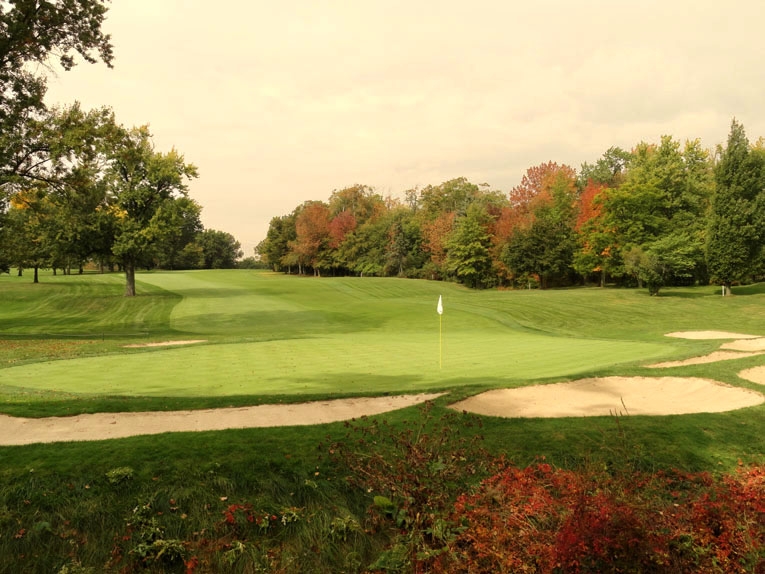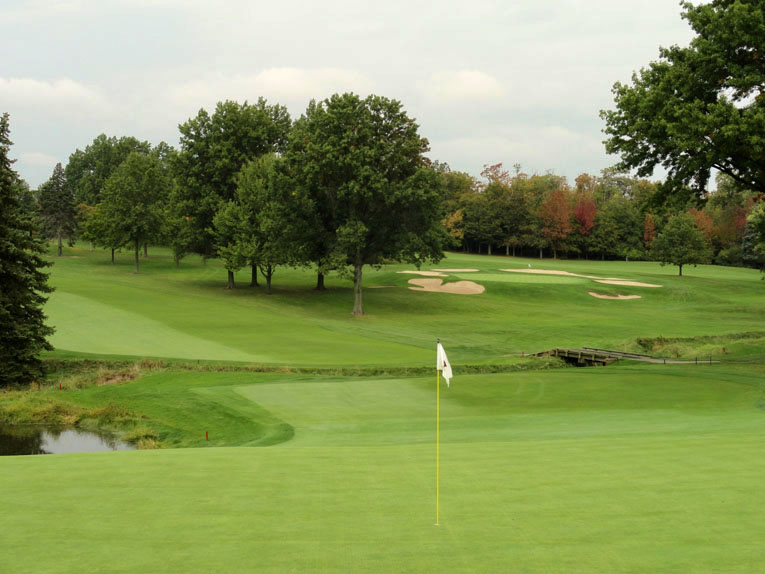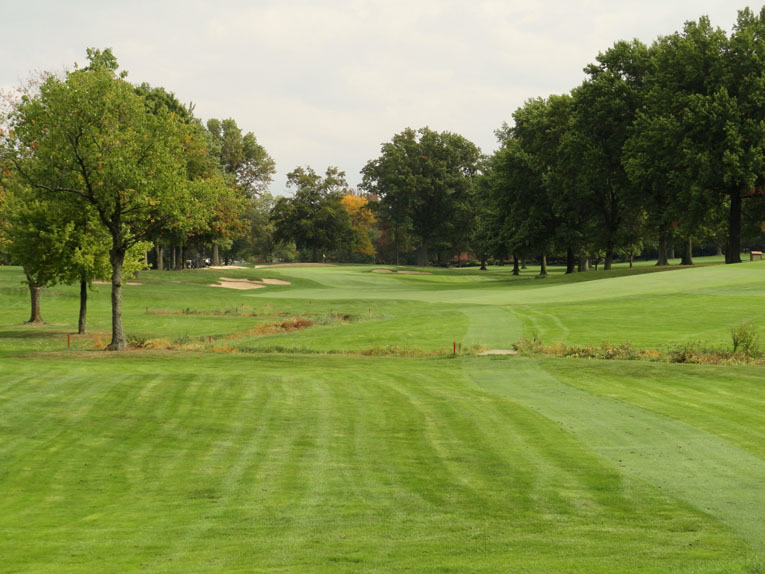Feature Interview with Bill McKinley
November 2013
1. Set the stage: tell us about Cleveland in early 1920s.
Cleveland was a growing city in the 1920’s. It was actually the 5th largest city in the country in 1920. Industry was abound, mainly the auto and steel industries. The Cleveland Indians beat the Brooklyn Robins in the World Series in 1920. And many of the great Golden Age golf architects were laying out golf courses over the rolling terrain of the Cleveland’s eastern suburbs.
Donald Ross had already designed Shaker Heights Country Club, which opened for play in 1915. And he designed Acacia Country Club (NLE) which opened for play in 1922. Stanley Thompson was hard at work completing the designs for Beechmont Country Club in 1923 and Chagrin Valley Country Club in 1925. William Flynn came to town during the late 1920s to create The Country Club and The Pepper Pike Club. CH Allison designed Kirtland Country Club in 1921. And of course, Herbert Strong designed Canterbury Golf Club, which opened for play in 1922. Also, AW Tillinghaust designed and built Lakewood Country Club on Cleveland’s west side in 1921.
Some might ask why so many great names in the Golden Age of golf architecture ascended upon Cleveland? But I have a feeling we’ll get to that later…
2. What was the origin of the club’s founding?
There was a meeting of prominent Clevelanders at the University Club of Cleveland who all shared a common interest. Their interest was building a club built for championship golf. As the story goes, members of the University Club were playing golf at Westwood Country Club and team Captains John York and LW Ellis first talked about the idea of forming a club with a nucleus of members from the University Club itself. After a rousing conversation at dinner with a large number of University Club present, a committee was formed and the ball had starting rolling for the creation of Canterbury Golf Club.
3. How was Herbert Strong selected to design the course?
By all accounts, Herbert Strong was a busy and popular man in the 1920s. A quick look at his design credits reveals about 9 or 10 golf courses under the Strong name that he designed or made changes to during that decade.
He had come to the US in 1905 and soon thereafter he became the Head Professional at The Apawamis Club in New York. By the time Mr. Strong came to design Canterbury, he had already a done work at Apawamis, then a major overhaul at Inwood Country Club and then a very successful design at Engineers Club. He was definitely a big name in the industry for those looking at building a golf course.
As to why he was chosen for Canterbury, there isn’t anything 100% definitive but we can point towards the Club’s origin and Strong’s record as an excellent player as to why the Club’s founders chose Strong to design Canterbury. He had played in many Major Championships and with the Club’s desire to have a course built for championship golf, what better man to choose than Strong.
4. Tell us about the bare land with which he was given to work.
The terrain of Canterbury is tremendous. There are many rolling hills which Strong used masterfully. Reverse camber on doglegs, thrilling blind shots, uneven lies, and rumpled blanket fairways and a good amount of elevation change are all prevalent. The elevation change is abrupt at times, like the 2nd shot at #15, and subtle at times, like from #17 tee up to #18 green. The 18th green sits 7 stories higher than the 17th tee. So 17, a 230 yard par 3 and 18, a 440 yard par 4, play much longer than the yardage indicates. However when I tell people how far uphill it is from 17 tee to 18 green, they usually scoff at the notion, that is until they play those holes.
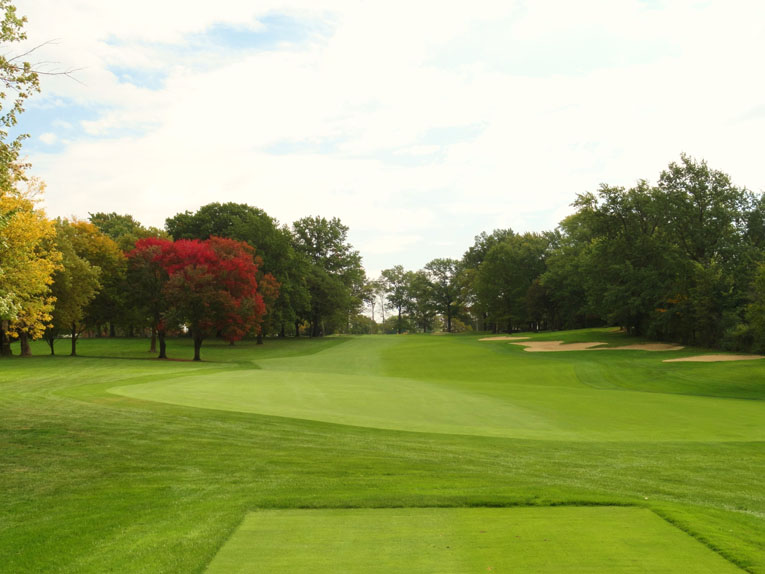
As seen from the tee, the 18th climbs uphill. Getting above the hole on any elevated Strong green is an occurrence that the golfer will soon regret. Ben Hogan three putted from eighteen feet above the hole on the 72nd hole of the 1946 US Open and missed a play-off by one.
Very rarely do you find yourself with a flat lie hitting to a flat green at Canterbury. At the magnificent 4th hole, the hogs back fairway challenges players to hit a pure shot with the ball above or below their feet. But the open front to the green and the usual firm conditions give the player many options to consider for their approach.
I could really go on and on about the bare land and terrain of Canterbury. It is something that has revealed itself to me over the years of playing here. This is why I’m very excited about the tree removal that we have done over the past few years and continue to do. It opens up great, long interior views which highlight the land. I would be remiss if I didn’t mention the fabulous work of Michael LoPresti, our Golf Course Superintendent, and his tireless, hardworking staff. Michael has really embraced the idea of firm and fast playing conditions and the product that he produces on a day in and day out basis is a sheer treat to play. And it’s only going to get better.
5. How do the eighteen holes that were being played in 1922 compare to the one’s today?
When Canterbury opened for play in 1922 it was 6,202 yards par 72. The 1st nine is essentially the exact same as it was back then. In fact, the members tees today are less than 100 yards longer than they were in 1922. However, on the 2nd nine, holes 10-14 experienced some reconfiguring. Strong’s layout on those four holes was…
#10: Par 3, 152 yards #11: Par 4, 288 yards #12: Par 5, 447 yards #13: Par 3, 142 yards #14: Par 4, 351 yards
Then, between the years 1922 – 1939, Jack Way, who was Mr. Everything at Canterbury at the time, made some changes to those holes. He changed the 10th hole completely, making it closer to the 9th green and made it a wonderful short par 4 of about 340 yards. He then used what was an empty space of land and turned it into the par 3 11th hole. Then essentially used the same land of Strong’s old 11th and 12th holes for the new 12 and 13. Finally at the par 4 14th Way relocated the green from a low area with a creek fronting the green, to an elevated green at the top of a plateau, adding roughly 50 yards to the hole. All this work was completed before Canterbury’s first US Open in 1940.
One other small change was at the iconic par 5 16th. When Canterbury opened in 1922, the 16th hole was a 662 par 6! Compare that with today’s meager par 5 of 617 yards from the Championship tees. Now there is some debate as to where the tee was located and how accurate the yardage was recorded back in 1922 over the rolling terrain of the 16th, but either way it was a true 3 shotter, or 4 shotter, then and still is today.
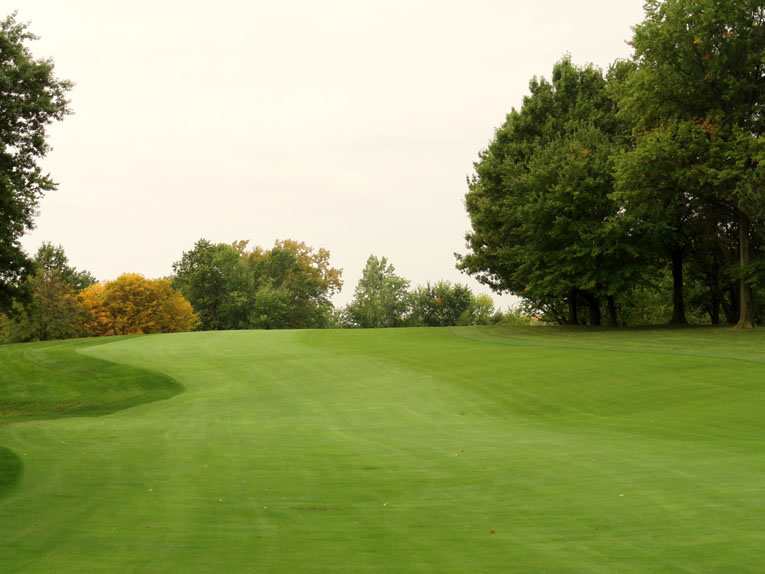
The tee ball at 16 needs to find the fairway so that the golfer can then clear, or at least get on top of, this ridge with his second. Otherwise, the third shot is blind.
I have heard many people with much more knowledge of GCA say that par 5s are the toughest to design. Well if that’s the case, then I give Herbert Strong a huge tip of the cap for his work at 16. No hazards, save for the greenside bunkers, just the lay of the land defend par and give golfers fits, where they are trained to think that par 5s are easy holes.
6. Tell us more about J.H. Way.
As I said earlier he was Mr. Everything to Canterbury in the early stages of the Club. An article from the Greenskeepers Report in the late 1930s describes Way as the Course Manager. He was pretty much in charge of everything outside the clubhouse from the outset of the club, for the better part of 30 years. He is listed in Club records as one of the Club’s Golf Professionals, but his first area of expertise was turfgrass. During the 30s and 40s Way was recognized as one of the country’s finest turf experts. In my mind Canterbury owes a lot to Jack Way. It was his changes to the golf course that attracted the USGA to bring the National Open to Canterbury twice in the 1940s (1940 & 1946). And his commitment to presenting one of the finest conditioned golf courses has carried over many generations later.
He was not a one man band, however. Articles from the 1930s describe the team of Way, Malcolm McLaren (Green Superintendent) and Waldo Crowder (Associate Professional) as Canterbury’s “Big Three.” Those men were on the cutting edge of the golf business and Canterbury was definitely on the national radar as a result of their efforts.
7. Along with some holes at Pine Valley, the fifteenth is among a handful of the most fierce, intimidating holes built during the age of hickory golf. How has technology altered how it plays in big tournaments over the past ninety years?
That is a bold statement, but I like it! In the days of hickory the 15th hole had to be close to impossible for most recreational golfers. A good drive leaves them roughly 140 yards dead uphill off a downhill lie with that menacing hillside staring them in the face. A better drive would leave the player roughly 110 yards off a flat lie, but obviously much closer to the steep hill, thus making it a huge task to elevate the old golf ball that quickly. There are still plenty of players today that can’t get the hillside out of their heads when hitting their shot. The bogey golfer or worse can definitely execute the required shot, but the bold and intimidating hillside demands a solidly struck shot. At the Tour level, however, technology has made the 15th hole quite a bit less intimidating. If we use our most recent Major Championship as the barometer, it played as the 2nd easiest par 4 on the course and the 4th easiest hole overall. At the Tour level these days the 15th hole requires a solid hybrid and a short iron to yield a birdie chance.
But I have seen good players, scratch players suffer greatly on the same hole. I watched a solid single digit handicap player at our club make a 9 on the hole even after reaching the green in regulation. The greens were quite fast and this player’s ball rested on the top shelf, while the hole was located on the front part of the green. The first putt was much too bold resulting in the next shot coming from 40 yards off the green, and you can imagine what happened from there.

Strong built some of the most famous holes in the United States during the 1920s, including the 2 or 20 hole at Engineers and the confrontational 15th at Canterbury. Imagine the club golfer having to climb this forty foot gnarly embankment with hickories!
Either way it’s a still a great hole and a wonderful use of the natural topography, which is an overriding theme of what makes Canterbury special.
8. From hickory shafts to drivers with 460cc heads, Canterbury has withstood the onslaught of technology. At the heart of the matter are its greens. Please give us a general overview.
I had a conversation with a friend about the greens at Canterbury not too long ago and I was surprised, in a good way, of how many great greens he thought we have. I have the utmost respect for them though years of playing them and seeing and talking to players about them, so it was nice to hear an outside view that backed up my thoughts. In my opinion the single biggest factor as to what makes the greens at Canterbury so special is their subtlety. There are times that I look at a putt that I have and I say, ok this is going to break 2 feet from right to left…But if I push it or end up playing it 2 1/2 feet, then it’s not really going to break at all. Now that’s not a mindset to help you make a bunch of putts!!
Talking with longtime members and caddies, most will pinpoint #6, 12, and 14 as the ones that are the most difficult to read the breaks. The many humps and bumps of #6, the deceiving putts that always break towards the entrance road at the 12th and the spine down the middle of the 14th green make players shake their heads each and every day.
Canterbury is a thinking man’s golf course and as you said, the heart of the matter is on the green. You stand in the fairway with an uneven lie and just know you have to put the ball in the proper position or things will not easy. So whether you are playing with hickories or you have the latest and greatest in technology, you still have to execute. And that is not always the easiest thing to do in golf when this game is played mostly on the 6 inch golf course between your ears (Thank you Bobby Jones).
9. Cleveland may well be the single most underrated city in America for golf. In particular, its eastern suburbs are full of great golf. Many of the greatest architects of all-time have worked here – Flynn, Alison, Thompson, Ross, and of course Strong. How does Strong’s work compare?
All the obvious reasons are there are to why the East side of Cleveland had numerous highly respected Golden Age architects laying out golf courses there during the 1920s. 1. Close to a major metropolitan area. 2. Excellent, varied terrain. 3. Moderate climates that made for excellent growing conditions.
As far as how Strong’s work compares? I would say this: Canterbury is underrated by some because Herbert Strong is the architect. Strong does not have that iconic design to draw off of like Flynn or Ross. He has what I would call a very nice portfolio, headlined by Canterbury, Saucon Valley and Engineers. But there’s no Seminole, Pinehurst #2 or Shinnecock Hills on Strong’s list of courses which could lend more credibility to all of his designs. But at the end of the day, Strong’s work at Canterbury holds up favorably to any other course in and around the Cleveland area.
As far as your comment about Cleveland being an underrated city for golf in America, I certainly can vote for that. But I think the underrated tag happens because it’s not as big of a city as it once was and it’s in the Midwest. Most of the talk around great golf cities centers around coastal areas, with possible exceptions being Chicago and Philadelphia. However, both of those cities are definitely larger than Cleveland, thus more folks to talk about how great their city is for golf.
10. Many of the golf’s legends have won here – Palmer, Nicklaus, Hagen, Guldahl, Bill Campbell, the list goes on. What is it about the course that produces the best from the best?
Excellent question. Canterbury is very proud of their major champions and the list of those who have won here. I would definitely throw in Lawson Little’s name in there as a notable champion at Canterbury. He of course won the 1940 US Open in a playoff over Gene Sarazen. Little had a tremendous career as an Amateur. He is the only golfer in history to win both the US and British Amateur’s in the same year more than once. He did in consecutive years (1934 &1935). Also, Mark O’Meara winning the US Amateur in 1979 was a great accomplishment vs. one of the best fields I’ve seen in a US Amateur. Over a dozen soon-to-be tour players, including Hal Sutton, Fred Couples, Payne Stewart and John Cook, all qualified for match play.
But back to your question, I think the reasons that Canterbury produces great champions are this: There are a fair number of blind shots, there are a lot of uneven lies in the fairways and the greens are treacherous. Those factors tend to create uncertainty in a tournament players swing and/or putting stroke. Thus the best players tend to separate themselves from the pack over the course of 72 holes.
11. Some unusual things have occurred during big events. Tell us about a couple of the more noted ones. What are the strengths and minuses of Canterbury’s geographic location?
The two most notable occurred during both US Opens that Canterbury has hosted. First in 1940, Ed “Porky” Oliver was one of 6 players to be disqualified after the final round of the tournament. Oliver was among a group of players that started their final round before their scheduled tee time because it looked like rain was imminent. However, Oliver played a magnificent final round and carded a 72 hole score of 287, which would have put him in a playoff with Lawson Little and Gene Sarazen for the US Open title. However, when officials from the USGA found out that Oliver was among the players that tee off too early for their scheduled tee time, they were all DQ’d. And despite pleas from both Little and Sarazen to allow Oliver to compete in the playoff, the USGA stuck to their work and Oliver remained disqualified. Also of note in the 1940 US Open, the flamboyant and talented Walter Hagen was disqualified before his 3rd round. However Mr. Hagen was not early, he was too late for his tee time. And according to the USGA he “was late for his starting time due to a night of partying at his hotel.” Not all that surprising considering Hagen’s reputation as a man who liked to have a good time. And there is a photo in the men’s locker room at Canterbury showing Hagen running to the tee during the tournament. Next time you’re at Canterbury, make sure you look for that photo of The Haig.
The other strange occurrence happened during the 3 man playoff in the 1946 US Open. The playoff was between Byron Nelson, Lloyd Mangrum and Victor Ghezzi. All three players shot 72 in the first 18-hole playoff, thus forcing an additional 18-hole playoff. During 2nd 18, Byron Nelson’s caddie accidently kicked his player’s ball in the right rough on the par 5 13th hole, causing a one stroke penalty. Mr. Nelson lost by one stroke to Lloyd Mangrum. Years later Nelson was asked about this occurrence and, always the gentlemen, Lord Bryon said that it was just part of what happens in the game of golf. His caddie that week was a great young man and he has no ill feelings towards him. Also in that same event, Ben Hogan missed out on the playoff by a single stroke. He made a quadruple bogey 8 on the par 4 8th hole, with zero penalty shots. And he 3 putted the 72nd hole of the championship from 18 feet above the hole.
Canterbury’s geographic location has probably helped it land some of our past major championships. In the 30s and 40s, the USGA didn’t go much further west than Chicago to find a suitable venue. Also the temperate climate makes it always attractive for hosting a major event in the dead of summer. That still holds true today, while looking at the PGA tour schedule there are 2 stops in Ohio that are on the calendar every year (Muirfield Village & Firestone CC). As far as a negative where Canterbury is located, one would have to be the length of the golf season. Being that Canterbury is east of Lake Erie, sometimes spring is very slow in coming. I have seen plenty of snow flurries during Masters Sunday and beyond. However the fall is typically nice, again because Lake Erie is warmer in the fall than the spring. This October especially has been good for golf, plenty of days in the 70s with lots of sun and very little rain.
12. What drove Canterbury to reach out to Renaissance Golf and Bruce Hepner in the late 1990s?
Definitely it’s their motto and design firm belief in helping their restoration clients identify and restore their best features. They are not in the business of trying to put their own stamp on Canterbury. They would like to see it look as close as possible to what Herbert Strong and JH Way created over 90 years ago.
13. What has been accomplished since?
We have added some new back tees that bring the hole back to how it was intended to be played. There has definitely been a focus on tree removal and developing a forestry plan. Make no mistake Canterbury is a parkland golf course. We don’t want clear cut the place so you don’t see a single tree on the property, but the goal is to open up interior views, make sure that the trees you have are highlighted, not choked out by trees growing into more trees.
Bruce also has talked a lot about the natural aesthetics. Creeks and streams looking more natural and tee boxes sit closer to the ground, not unnecessarily built up. There are possibly some bigger things on the horizon, but nothing is official yet. Suffice it to say, I am happy that we are working with Bruce Hepner and the more I talk to him and walk the property with him, the more excited I get to think about his plans.
14. Talk about a specific hole and how its playing attributes have been altered/improved based on the restoration work.
The 4th hole is the one that sticks out in my mind. A new back tee box was added changing the yardage from 452 to 489. 489 seems like an excessive yardage, but given the way the hole was designed and how the hole plays, it is a fitting yardage for the low handicapper. Before, the player could hit the ball over the corner of the dogleg, carrying the fairway bunkers and leaving an approach of about 170 yards to wide open green. Now, with the new back tee, it’s about 300 yards to carry the bunkers on the left, so players will hit their tee ball towards the right side of the canted fairway enabling them to get a little extra distance on their tee shot and set up the proper angle for their approach. That approach is most likely from about 200 yards with the ball above your feet. Now the open front of the green comes into play much more being that most players will be playing shots that are lower and run out more on the firm approach to the green.
15. What has the club learned over the course of this restoration?
I’m not exactly sure, mainly because it’s still an ongoing process. If you ask that question to us at Canterbury in a few years maybe we will have a better answer. I know this, I’m glad I’m here during the process because it’s really fun to be a part of it and see the changes happening.
16. What remains to be done?
The biggest thing would be a bunker renovation. According to our records, the bunkers have never been renovated throughout Canterbury’s history. Some have been added, some have gone away, but never a full scale renovation project. Hepner has stated that we have a few different styles of bunkers, some Strong bunkers, some Geoffrey Cornish bunkers, and some Terry Bonar bunkers. (Terry Bonar was the Club’s superintendent for the better part of 40 years. He retired at the end of the 2009 season.) But, Hepner would like to see Canterbury with a singular bunker style and design. In addition to the bunker renovation, adding some width to some fairways, continuing the forestry program and there’s also been talk of adding some native fescue areas.
17. What either impressed and/or surprised you during the play of the 2009 Senior PGA Championship?
I was impressed with the way the players played the par 3 holes and by the way they handled the thick rough that week. We all know how thick rough can get in the spring and around the greens that week it was quite severe. However, I was very impressed with the short game shots that a lot of the players pulled off out of the thick rough onto the firm and fast greens.
It was surprising to see how high the scores were throughout the week. Early on during the first round, Scott Hoch was 6 under par through 16 holes. He promptly bogeyed 17 & 18 to finish with a 4 under par 66. Many of us were wondering how low the winning total was going to be and if Canterbury could still prove to be a tough test for the game’s top players. But by the end of the week, only 3 players finished under par, with Michael Allen’s winning total of 6 under par. It was then that I really bought into the idea that firm and fast conditions make conditions tougher, even though many holes play shorter.
18. Private club golf suffered an enormous blow in 2008 and 2009 when the economy soured. What steps has Canterbury undertaken to insure that it offers great value to its membership?
Canterbury is a wonderful place. We need to make sure as key employees continue to sing the praises of how special the Canterbury experience is and deliver that experience every day. The amount of disposable income among families has decreased due to the economic down turn, so we need to do everything we can to make sure current members still feel that Canterbury is a great value. Happy current members will attract new members.
The End



